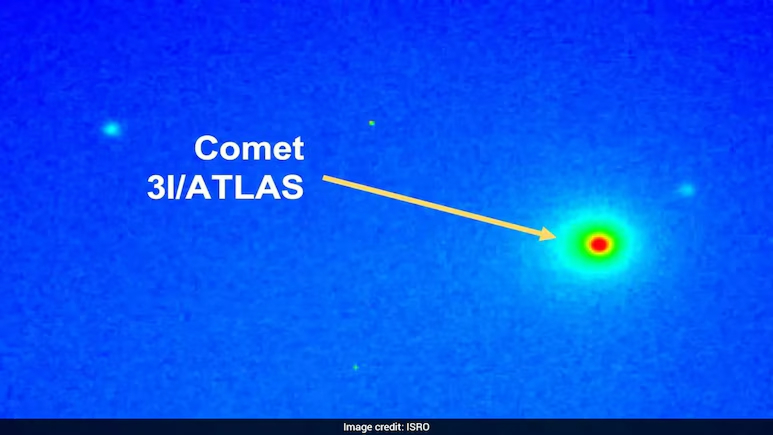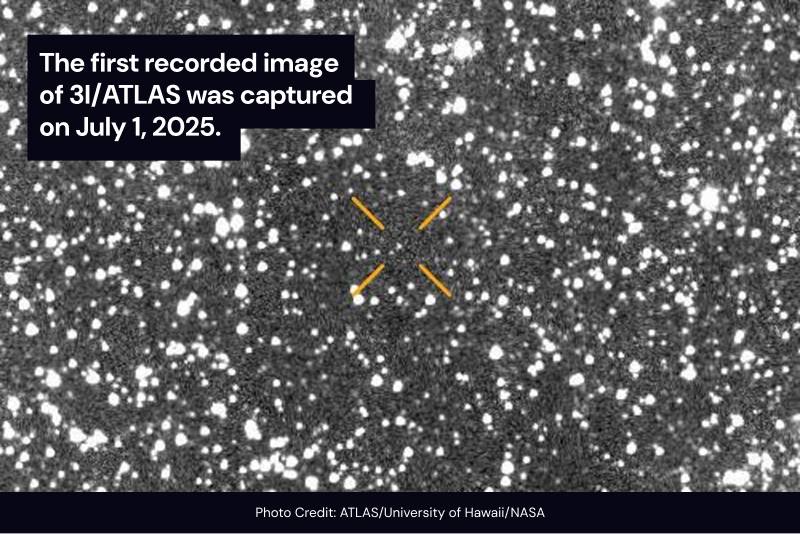ISRO Snaps Rare Images of Interstellar Comet 3I/ATLAS

India’s space agency has joined the global effort to study 3I/ATLAS, a comet from beyond our Solar System. Scientists at the Physical Research Laboratory (PRL), under ISRO, observed the comet from their 1.2-meter telescope at Mount Abu. Between November 12 and 15, they collected images and spectral data, helping to clarify its nature and activity.
Why This Comet Matters
Only a handful of interstellar objects have ever visited our Solar System, and 3I/ATLAS is one of them. Its unusual trajectory marks it as having originated from outside our stellar neighborhood — a rare opportunity for astronomers to study material from another star system.
What ISRO and PRL Discovered
- During a three-day run in mid-November, the PRL team used their Mount Abu telescope to image the comet’s coma — the glowing atmosphere of gas and dust — in false color.
- Spectroscopic readings revealed emission lines typical of comets in our Solar System, including CN, C₂, and C₃ molecules.
- The calculated gas production rate of the comet — how much material it is shedding — is around 10²⁵ molecules per second, which places it in a similar activity class as many normal, solar system comets.
- The false-color images show a nearly circular coma, and because of observation geometry, any dust tail would be pointing away from Earth, making it harder to detect immediately.
Breaking Down the Science
When a comet nears the Sun, its frozen ices sublimate (turn into gas), creating a fuzzy envelope called the coma. That’s what the PRL telescope clearly imaged. Spectroscopy — breaking the comet’s light into its component colors — lets scientists identify the molecules being released. The presence of CN, C₂, and C₃ suggests chemical activity like that of many comets in our Solar System, despite 3I/ATLAS’s interstellar origin.

Why These Findings Are Important
- Understanding Cosmic Origins: By studying the composition of an interstellar comet, Indian scientists contribute to knowledge about materials from other star systems.
- Global Collaboration: ISRO’s observations add a valuable ground-based data point to the network of telescopes worldwide following 3I/ATLAS.
- Comparative Science: Finding typical comet molecules in this visitor challenges assumptions that interstellar objects must be radically different, helping refine models of comet formation.
What Scientists Still Don’t Know
- While ISRO’s data confirms many familiar features, the tail structure (if any) remains difficult to observe clearly from Mount Abu due to geometry.
- The gas production rate, though measured, is a “snapshot” — comet activity can change rapidly, and more observations are needed to chart its full behavior.
- Because 3I/ATLAS is on a hyperbolic path, it will leave the Solar System again, limiting the time window for detailed measurements.
What Happens Next
- The PRL team plans follow-up observations as the comet moves into darker skies, enabling even better imaging and more precise spectroscopy.
- International observatories and space missions will continue tracking 3I/ATLAS as it departs, creating a long-term mosaic of its journey.
- Data from these observations could feed into updated comet models, especially for interstellar bodies — potentially influencing future missions or telescope proposals.
The Bottom Line
ISRO, through its PRL scientists at Mount Abu, has made a significant contribution to the global study of 3I/ATLAS. Their images and spectral data reinforce that this interstellar visitor behaves much like a typical comet from our system — offering a vital piece of the puzzle in understanding the diversity of celestial bodies across the galaxy.